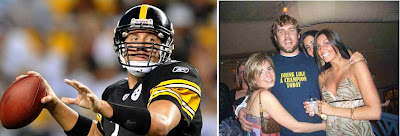Posted by Jay Livingston
Prediction is pretty easy, at least about the past.* Take the case of Ben Roethlisberger. Big Ben, as we all know (well, maybe not all of us, but those of us who follow important matters, i.e., the Steelers), was quarterback for Pittsburgh in two recent Superbowl seasons (2005-06, 2008-09. But has also behaved badly off the field – a motorcycle accident (sans helmet), sexual assaults.
 This should have come as no surprise. The signs were all there, waiting to be read. At least, that’s the gist of the headlines in the story featured on page one of today’s New York Times sports section.
This should have come as no surprise. The signs were all there, waiting to be read. At least, that’s the gist of the headlines in the story featured on page one of today’s New York Times sports section.How could we not have foreseen this? According to the headlines, since childhood apparently, Ben had been a six-game suspension waiting to happen. Here’s the logic:A Reputation in RuinsLong before his recent troubles, Roethlisberger, driven by athletics, showed signs of a sense of entitlement even at a young age.
- A few incidents of bad behavior show that Ben has some character/personality trait (recklessness, sexual assaultiveness).
- Because personality is an enduring part of our psychological make-up, he must have had these traits long ago.
The story of Roethlisberger’s pre-Superbowl life has absolutely nothing that foreshadows what the NFL, in its suspending him, called “a pattern of behavior and bad judgments.”
Making assumptions about someone’s past may not be the fundamental attribution error, but it’s close. We start with the idea that behavior is caused by personality traits, and we add an assumption of life-course consistency – the child is father to the man. And apparently a headline writer’s heart leaps up when he beholds a chance to impose those assumptions on a public figure. The online version (“Ben Roethlisberger’s Journey to Notoriety”) carries this subhead:
What seeds? The story itself (by Thayer Evans), which gives no evidence of these seeds, is quite sensible. It’s the headlines that are the problem. I suspect that the headline writer skimmed the story rapidly if at all, saw that it was about Roethlisberger’s past, and plugged in the erroneous psychological assumptions, taking Roethlisberger’s unremarkable teen years and turning them into something seedy.The seeds of the NFL quarterback’s problems, including
accusations of sexual assault, were sown long ago.
* “Making predictions is very hard, especially about the future.” – Yogi Berra (unsourced)





